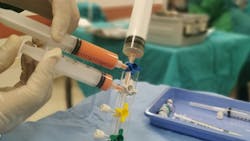Using cryopreserved hematopoietic progenitor cells during the pandemic
The use of cryopreservation of hematopoietic progenitor cells (HPCs) exploded during the pandemic for cord blood and bone marrow products, amongst others, according to a session at AABB’s annual conference, which the organization held virtually.
The presenters were Jeff Wren, Director, Be The Match BioBank, National Marrow Donor Program (NMDP); David H. McKenna, MD, Professor and American Red Cross Chair in Transfusion Medicine, Department of Laboratory Medicine and Pathology, Medical Director, Molecular and Cellular Therapeutics, University of Minnesota Medical School; and Stephen Spellman, Vice President of Research, NMDP/Be The Match, Senior Scientific Director, CIBMTR (Center for International Blood Marrow Transplant Research).
Before the pandemic, only 5-10% of the cord blood, bone marrow and other blood products that Be The Match supplied to hospitals and other providers were cryopreserved. Since the height of the pandemic, about 67% of the products the organization supplies are cryopreserved.
Previously, products being cryopreserved were used in last resort cases, such as when a patient required another round of chemotherapy or had acquired an infection.
Because of the rapid increase in the use of cryopreservation for all types of plasma and stem cell products, reports comparing patient outcomes before and after the pandemic may include skewed information. To clarify the numbers, since so many patients received cryopreserved products during the pandemic, Spellman said a new study on the viability and patient outcomes for cryopreserved products is scheduled to be released at the American Society of Hematology conference in December.
McKenna said the University of Minnesota started a cryopreservation program in the summer of 2020. He discussed how upon receipt of the HPC product, the school keeps it between 2-8 degrees Celsius, including if kept overnight, processing it normally within 24-36 hours, but some international cases may be extended to within 72 hours in extreme cases. The HPC products are shipped in a liquid nitrogen dry shipper, and for technical review, samples are tested for viability at different time intervals.
Wren mentioned the advantages of automated methods, including software for smart reduction of bone marrow and neat cell for bone marrow products.
Spellman pointed to studies showing no clinically significant differences for bone marrow when using fresh versus cryopreserved products; however, stem cells were a little different, as some had delayed neutrophil engraftment when using cryopreserved products, and aplastic anemia patients had higher graft failure rates with the cryopreserved.
In a CIBMTR study comparing hematopoietic engraftment, researchers saw no adverse impact of cryopreservation through 180 days post HCT, with only a slight delay (one day difference) in neutrophil , Spellman said.

